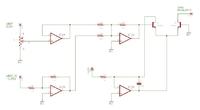juz_ad
Full Member level 2

I'm trying to set up a Linear to Exponential/Antilog current source to drive a transistor differential amp (that has a linear response).
Using a Linear current mirror with an input voltage of 0 to 2.5V, converted to approx. 0 to 10uA I get a nice straight linear response and unity gain at the output of the differential amp from 0 V PP to approx. 10 V PP - so I know the differential amp is working as required.
I would like to take the same control voltage of 0 to 2.5V, convert it to approx. 0 - 10uA (although I can be flexible about that...) and convert the output curve (Iabc) to an exponential response.
So far, the schematic above, made up from my own research and data sheets is not giving me the required response and adjusting the various resistor values just seems to be shifting the linearity/gain response upward/downward and not bringing me any closer to an exponential/antilog curve.
Can anyone offer any advice on component values I should be looking at, things I could check/change, what I might be doing wrong?
Thanks in advance.